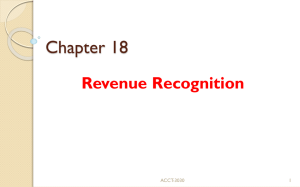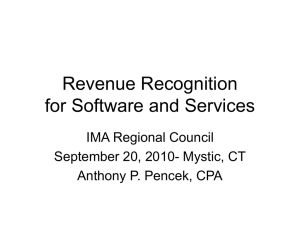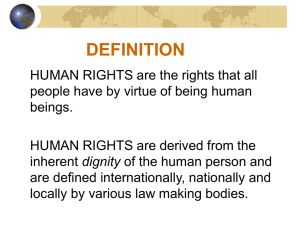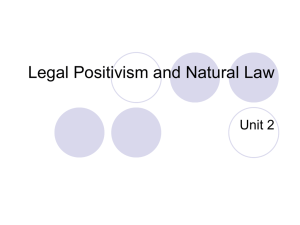The New Revenue Recognition Standard and the Software Industry
advertisement
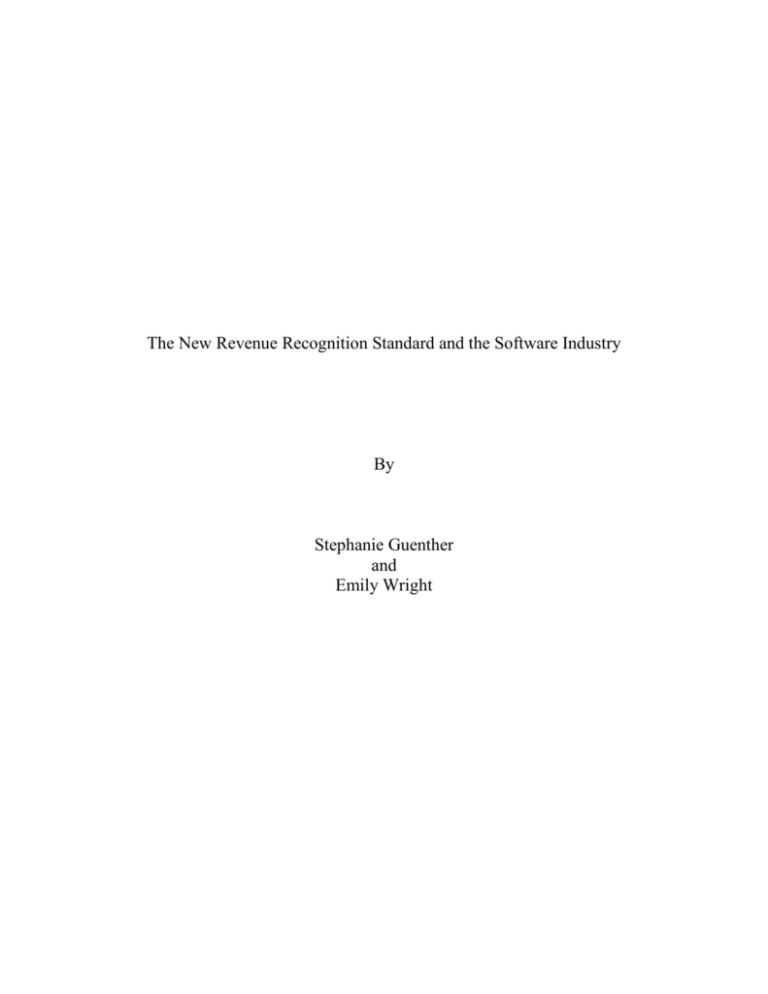
The New Revenue Recognition Standard and the Software Industry By Stephanie Guenther and Emily Wright Introduction and Overview On May 28, 2014, the FASB issued a new standard for revenue recognition requirements. The FASB worked alongside the International Accounting Standards Board to create this converged guidance. “The objective of the new guidance is to establish the principles to report useful information to users of financial statements about the nature, amount, timing, and uncertainty of revenue from contracts with customers” (fasb.org). This new guidance may be the “biggest accounting change the world has seen in over a decade” (pwc.com). Companies will now follow a five-step model for recognizing revenues. There are many benefits that will arise from this accounting change. This new guidance will: “Remove inconsistencies and weaknesses in existing revenue requirements Provide a more robust framework for addressing revenue issues Improve comparability of revenue recognition practices across entities, industries, jurisdictions, and capital markets Provide more useful information to users of financial statements through improved disclosure requirements Simplify the preparation of financial statements by reducing the number of requirements to which an entity must refer” (fasb.org). All industries will be affected by this update, but companies will have time to adjust and prepare for the implementation of this change. For public organizations, the update is effective for annual reporting periods beginning after December 15, 2016, and for nonpublic companies the update will be effective after December 15, 2017 (fasb.org). An industry that will be especially affected by the change is the technology and software industry. This change will be challenging, but very beneficial for this industry. The Five Steps The core principle of this change is that entities should “recognize revenue to depict the transfer of promised goods or services to customers in an amount that reflects the consideration to which the entity expects to be entitled in exchange for those goods or services” (fasb.org). The five-step model was created to help achieve this core principle. The five steps include: 1. Identify the contract(s) with a customer 2. Identify the performance obligations in the contract 3. Determine the transaction price 4. Allocate the transaction price to the performance obligations in the contract 5. Recognize revenue when (or as) the entity satisfies a performance obligation (fasb.org) Step 1: Identify the contract(s) with a customer The first step in this model is identifying the contract with a customer. A contract is an “agreement between two or more parties that creates enforceable rights and obligations” (bkd.com). The new revenue recognition requirements will be applied to contracts that meet the following criteria: “Approval and commitment of the parties Identification of the rights of the parties Identification of the payment terms The contract has commercial substance It is probable that the entity will collect the consideration to which it will be entitled in exchange for the goods or services that will be transferred to the customer” (fasb.org) In terms of the software and technology industry, companies will follow these criteria to identify a contract with a customer. They will have to assess whether a single contract should be used or if multiple contracts should be created when selling a software package (kpmg.com). If these criteria are met and the contract is identified, companies will move on to step two, identifying performance obligations, for which the standards have changed for this industry. Step 2: Identify the performance obligations in the contract According to the new standard, a performance obligation is a promise in a contract to transfer a good or service that is distinct, or a series of “distinct goods or services that are substantially the same pattern of transfer to the customer” (pwc.com). To determine if a good or service is distinct, certain criteria must be met: The good or service on its own or together with other resources can benefit the customer The good or service is separately identifiable from other goods or services in the contract (pwc.com) The pattern of transfer of the good or service differs from other goods or services (kpmg.com) In terms of the technology industry, companies will need to identify if contracts include multiple performance obligations. Most sales by technology companies include multiple products or services, such as selling the software along with an update. Companies will need to evaluate and decide if these separate goods and services should be classified as a single performance obligation or multiple performance obligations. The transaction price is allocated to each separate obligation based on their individual selling prices. Under the new standard, companies will no longer use the vendor specific objective evidence (VSOE) of fair value to “separate and allocate contract consideration to the various promises in a contract” (pwc.com). Technology companies will now identify separate performance obligations by evaluating whether the component is distinct. Items are accounted for separately if they meet the above criteria unless: 1. “Highly inter-related and significant integration service 2. “Bundle is significantly modified or customized for customer” (kpmg.com) Step 3: Determine the transaction price The transaction price in this step is defined as “the amount of consideration to which an entity expects to be entitled as a result of the satisfaction of the performance obligations” (eidebailly.com). Consideration could be variable from incentives (discounts etc.) or performance-based fees, and it will be estimated by either the expected value or the most likely amount method (kpmg.com). The end result would likely mean that the most significant changes to retrospective adjustments are dependent on lengths of time in between transfers and payment (eidebailly.com). Step 4: Allocate the transaction price to the performance obligations in the contract This step attempts to allocate to separate performance obligations in “proportion to their relative stand-alone selling prices” (kpmg.com). In the current industry procedures, there is a requirement of allocating consideration to individual deliverables, using “vendorspecific objective evidence” of fair value to allocate the transaction price, but if it does not exist, the revenue is deferred (mhta.org). Under the new guidance, the entity will have to use fair value and avoid revenue deferral for software transactions (mhta.org). The company will attempt to estimate these prices when they are not directly available using approaches like: Adjusted market assessment – estimation of price that customers would pay for sold product through the price of similar products in the marketplace and making adjustments Expected cost plus a margin- “estimating company’s projected costs for good and then adding an appropriate margin” Or residual– when prices are highly variable or uncertain and observable prices are available for remaining obligations, this is used (kpmg.com) When estimating this price, a company should consider market conditions, entity-specific factors, and information or class about the customer (mhta.org). This change would allow software companies to use the residual method, which was not allowed previously, and also in certain circumstances be able to allocate discounts to all separate performance obligations by the observable stand-alone selling prices (kpmg.com). Step 5: Recognize revenue when the entity satisfies performance obligation This step provides more details to the criteria of recognizing revenue through the transfer of control of a good or service. Specifically, it “assesses whether a performance obligation is satisfied over time or at a point in time” (kpmg.com). The central point is that a company must determine if the obligation is complete over time, and if it does not, then revenue is recognized when control transfers to customer. For the technology industry, many contracts like integration and consulting may qualify for revenue to be recognized over time. For software developers, it is not as simple. To meet the criteria, the software being developed must be advanced enough to be defined as a construction contract (kpmg.com). Another significant impact of this step is the accounting for licenses. The license needs to be determined if the performance obligation is one that is satisfied over time or at a point in time and done so based on whether it should be bundled with other goods and services (mhta.org). If it is determined as an obligation satisfied at a point in time, the result will likely be accelerated revenue recognition (mhta.org). More specifically, it will be recognized when the customer obtains control of rights to the software or intellectual property provided. Preparation for the Change Companies should start preparing for this change in revenue recognition standards. Technology companies, especially, should consider the potential impact of these changes within their financial reporting, operations, internal systems, and communications (kpmg.com). The best way to do this is through considering the following: Contract analysis- technicians will be required to analyze terms and conditions of contracts, determine the number of performance obligations, and consider if they meet the recognition of revenue over time or at a point in time criteria Compensation contracts with sales staff and external agents - incremental commissions should be revisited with the idea that because of this change in standards, some costs may be required to be capitalized. Commissions paid based on target revenues should be evaluated with the idea that the timing of revenue recognition may change due to this new guidance. Staff training- because there will be changes in accounting practices, operating practices may change as well. Parallel record-keeping may be required in periods preceding effective date to provide necessary figures to compare Setting expectations up front- this new standard will affect the timing of revenue recognition for technology companies, and this should be communicated with investors and analysts. Disclosure requirements- the new standard requires more extensive and detailed disclosure notes, so companies should start recording additional data to meet these new requirements (kpmg.com). These preparations are necessary for companies to take within the next year before the changes will be put into effect on December 15th, 2016. GAAP vs. IFRS U.S. GAAP and IFRS will both be subjected to these changes, and it has been an expectation that this will lead to a closer merging between the two methods. Unlike U.S. GAAP, the standards will be effective for all entities under IFRS for annual periods on or after January 1, 2017, and early adoption is permitted for reporters (pwc.com). Specifically, many technology companies that provide multiple products or services under a single arrangement, and under the new standards, these separate performance obligations need to be identified based on terms of contract or remain as single performance under specific facts (pwc.com). Under GAAP, making this distinction may just require judgment, and indicators will be provided. Under IFRS, they will also need to use judgment but the distinct goods and services are more specific and result in more performance obligations being identified (pwc.com). An example of the difference is that if software can only be implemented by the vendor that sold it, then it qualifies as single performance obligation and if that software does not have significant customization, then it qualifies as separate performance obligation (pwc.com). This recognition allows for GAAP and IFRS to report their revenue in a dissimilar fashion. There are many other changes to the standards that affect GAAP and IFRS methods, but they allow for a more like style. Conclusion This change will be very beneficial for all industries. The converged standards will make comparability between companies following US GAAP and companies following IFRS much easier. Revenue recognition under GAAP and IFRS will be much more consistent and more beneficial for external users regardless of geography or industry (fasb.org). The five-step model provides a very good outline for companies to follow when reporting and recognizing revenues. Revenues will be recognized as performance obligations are satisfied, and the new standards make identifying separate performance obligations easier by providing specific criteria the obligations must meet (fasb.org). The transaction price is allocated to performance obligations based on their stand-alone selling prices. Accounting for variable consideration included in the transaction price will now be the same across all industries (fasb.org). More extensive disclosure notes will provide users with much more valuable information about contracts with customers that they were not provided previously. Technology and software companies will have to reconsider their revenue recognition principles in anticipation of the implementation of these new standards. In preparation for the coming changes, companies should consider whether to take a retrospective or modified retrospective approach to implementation (mhta.org). It will be a difficult, but worthwhile change to the technology and software industries in the long run.
